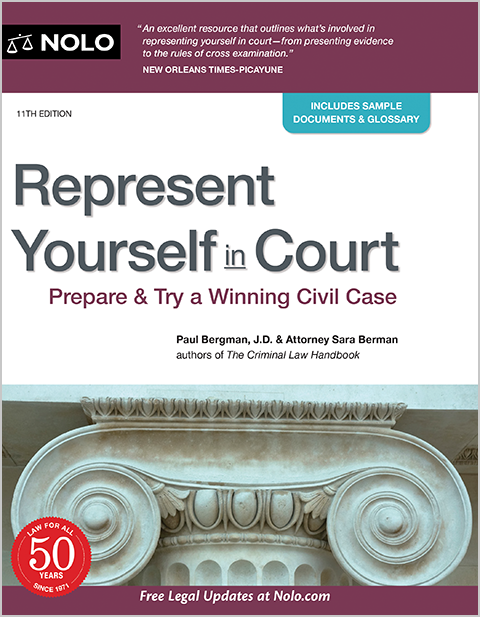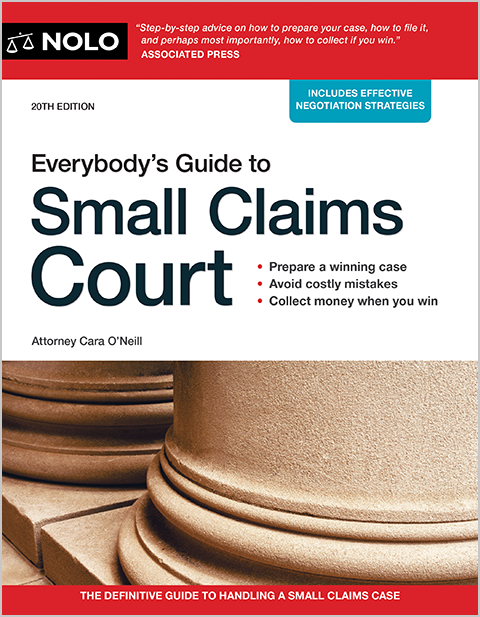The plaintiff no-showed and you want a dismissal. But some dismissals are better than others. We explain the kind of dismissal you want, how to get it, and more.
After being sued in small claims court, you did everything you were supposed to do. You prepared your defense, lined up a witness to testify, and showed up for the hearing, with your witness, ready to go. The plaintiff—the person who sued you—was a no-show. What happens next?
The answer is: It's up to the judge. First, the good news. The judge most likely will dismiss the plaintiff's case. If you responded to the plaintiff's claim with one of your own, the judge will probably decide your claim without the plaintiff being present.
Now, for the bad news. Even if the court dismisses the plaintiff's case, there's a chance it will resurface. A lot depends on why the plaintiff didn't attend the hearing.
In this article, we explain:
- why it's essential that the plaintiff shows up in court
- what you should ask the court to do if they don't
- the two kinds of dismissals the court might grant
- why you want to move ahead with your claim, if you brought one in response, and
- when the plaintiff might get another chance to sue you.
Filing a Complaint Isn't Enough
The plaintiff's allegations in their small claims complaint are just that—allegations. Before the plaintiff can win, they must present evidence in court proving the truth of the facts they alleged. The need for in-court proof makes it virtually impossible for the plaintiff to win without showing up. An example will illustrate.
Plaintiff Mary Roe sued defendant John Doe in small claims court. Mary claims that John negligently ran into her, knocking her down and destroying her expensive designer sunglasses. To receive reimbursement for her damaged property, Mary will need to prove each of these elements of her claim:
- John failed to act reasonably under the circumstances
- John's negligence caused Mary's property damage, and
- the dollar amount of her property loss.
Mary has the burden of proof, meaning it's her job to convince the court that her claim is more likely true than not true. If she doesn't appear in court to present evidence of each element, she won't meet that burden. The judge will probably dismiss her case.
On the other hand, Mary can win if she shows up at the hearing and presents this evidence:
- her testimony about how the incident happened
- witness testimony describing John's behavior and saying that he wasn't paying attention when he ran into Mary
- the destroyed sunglasses, and
- a receipt showing the cost of the sunglasses and when Mary bought them.
If Mary's proof is satisfactory, the judge will award her a money judgment against John. Learn about what to expect at a small claims trial, and find out how to collect a money judgment.
Ask the Court to Dismiss the Plaintiff's Case
So, let's return to our opening example. You got sued and showed up for court. The plaintiff didn't appear. The first thing you should do is ask the court to dismiss the plaintiff's case. Here are the kinds of dismissals the court might grant, and how you ask for one.
Kinds of Dismissals
There are two ways a court can dismiss a plaintiff's legal claims, a defendant's defenses, or an entire case.
- Dismissal without prejudice. In legal terms, this means a dismissal without prejudice to refiling. That's a fancy way of saying that the plaintiff can refile their claims as long as the statute of limitations—the deadline for filing legal claims in court—hasn't expired. Generally speaking, courts prefer to grant dismissals without prejudice.
- Dismissal with prejudice. When a claim or case is dismissed with prejudice, it's been dismissed with prejudice to refiling. In other words, barring extraordinary circumstances (discussed below), the plaintiff isn't allowed to bring the case back to court later. If you're the defendant, you prefer a dismissal with prejudice over one without prejudice.
Note, too, that these two dismissals aren't mutually exclusive. A court might dismiss one claim in a lawsuit without prejudice, and a second claim with prejudice.
Find out about your state's statutes of limitations for specific kinds of lawsuits.
How to Ask for a Dismissal
If the plaintiff doesn't appear, ask the judge for permission to speak. Then say to the court, "Your Honor, I ask the court to dismiss all of the plaintiff's claims with prejudice for failure to appear." You're asking the judge to dismiss the case because the plaintiff was a no-show. And you're asking that the dismissal be once and for all—again, absent unusual circumstances.
If you responded to the plaintiff's claim against you with a claim against the plaintiff (discussed in the next section), and if you want to continue on with your claim, then make sure your request to dismiss is clear. You're asking the court to dismiss only the plaintiff's claims against you, not the entire lawsuit. Simply tell the judge you want to proceed with your claim against the plaintiff.
When You've Also Filed a Claim Against the Plaintiff
Let's change the facts of our Mary against John case above. In response to Mary's lawsuit, John files a claim against her, too. At the time they collided, John was carrying a large cup of very hot coffee. The coffee spilled on John's arm, causing second-degree burns that required medical care. He thinks Mary was negligent, and wants to be paid for $600 in medical bills.
John's claim against Mary is called a counterclaim. The state's court rules likely say that because his injury arose out of the same facts as Mary's claim against him, John has to bring his claim as a counterclaim to Mary's lawsuit. In other words, the rules say he can't file a separate lawsuit against Mary for his injuries.
Now, let's assume that John shows up ready to go, but Mary doesn't appear. John should ask the judge to:
- dismiss Mary's claim against him, with prejudice, and
- enter a default judgment against Mary for his medical bills.
A court can enter a default judgment against a party who doesn't show up for court. John will need to present evidence of his $600 in medical bills. Copies of the bills will do.
Vacating a Default Judgment or Dismissal After a No-Show
A dismissal with prejudice or a default judgment doesn't necessarily mean the end of the case. The party who's on the losing end of a dismissal or default judgment can ask the court to "vacate" (undo) the order. A judge is more likely to grant a motion to vacate if both of the following are true.
- Prompt request. The party making the request asks to have the judgment or dismissal vacated promptly upon learning of their mistake. State law almost certainly sets the deadline for making this request—likely 10 to 30 days—but the sooner the better.
- Good cause. The party making the request has a good explanation for why they were unable to be present or call on the day the case was scheduled. A judge might accept something like this: "I had the flu with a high fever and lost track of a couple of days. As soon as I felt better, which was two days after my case was dismissed, I came to the clerk's office to try to get the case rescheduled."
If you want to get a default judgment or dismissal with prejudice vacated, check the small claims court website for the rules and forms you should use. If you don't find what you need online, call the clerk's office or use the self-help resources located in many courthouses.
Next Steps
All things considered, the plaintiff's failure to appear in court might turn out to be a good thing if you're the defendant. True, you've been inconvenienced. But there's a chance the plaintiff's claims will disappear for good, and you're still allowed to proceed with your own counterclaim, if you brought one.
Anytime court rules and proceedings are involved, things can get complicated and confusing. Small claims court, while simpler than regular court, is no exception. If you're unsure about what to do or how to handle your small claims matter, a local attorney can help you sort through the red tape and chart a course to your best possible outcome.



